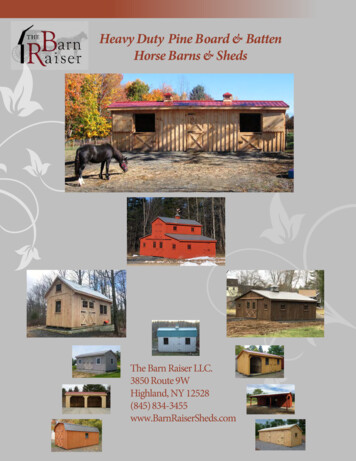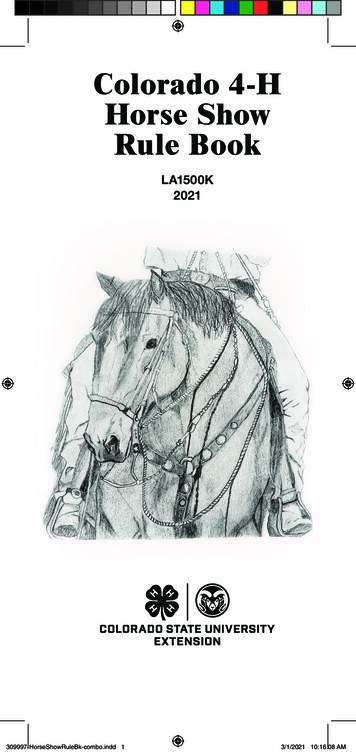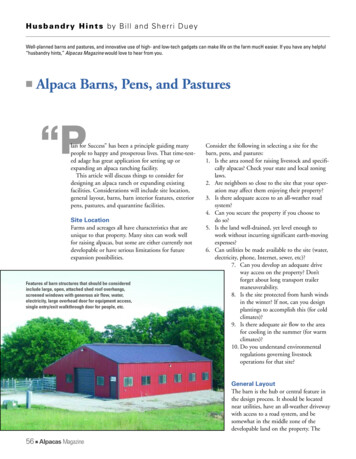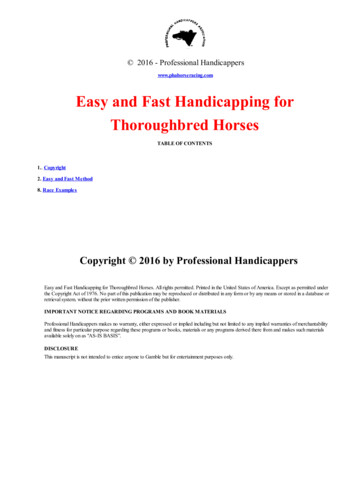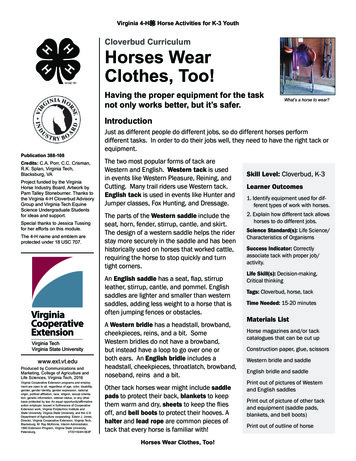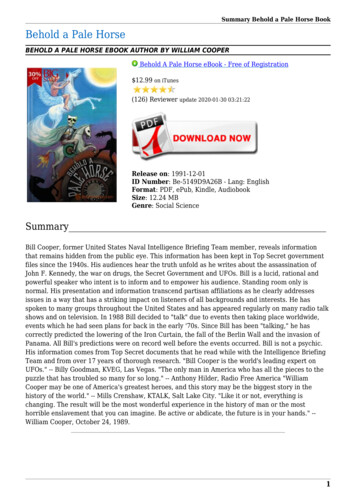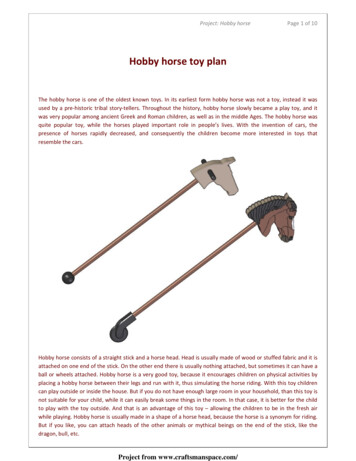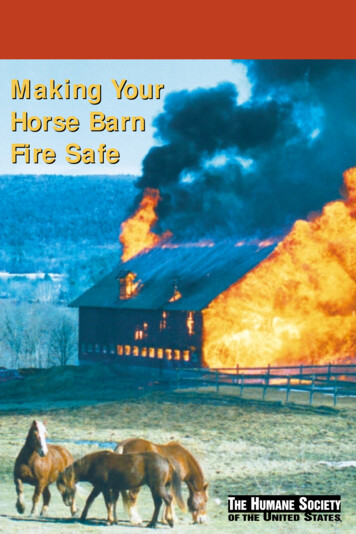
Transcription
Making YourHorse BarnFire Safe
Cover: Barn at the Northfield Mount Hermon School in Gill, Massachusetts ablaze. Craig Hefner, Northfield Mount Hermon School
ContentsAcknowledgements2Introduction3Part 1: Fire Safety Precautions for Existing Barns5No Smoking. . . . . . . . . . . . . . . . . . . . . . . . . . . . . . 6Restrict Access . . . . . . . . . . . . . . . . . . . . . . . . . . . . 6Keep It Clean . . . . . . . . . . . . . . . . . . . . . . . . . . . . . 7Keep It Cool . . . . . . . . . . . . . . . . . . . . . . . . . . . . . 8Spontaneous Combustion Warning! . . . . . . . . . . . . . 8Don’t Let the Electrical System Slide . . . . . . . . . . . . 9Lightning Protection . . . . . . . . . . . . . . . . . . . . . . . 10Fire Prevention outside Your Barn . . . . . . . . . . . . . . 11Carbon Monoxide Warning!. . . . . . . . . . . . . . . . . . 13Part 2: Responding to a Fire15Heat and Smoke Detectors . . . . . . . . . . . . . . . . . . 15Evacuating Your Barn. . . . . . . . . . . . . . . . . . . . . . . 17Fire Suppression Techniques . . . . . . . . . . . . . . . . . . 19Fire Suppression Warnings! . . . . . . . . . . . . . . . . . . 19Portable Fire Extinguishers . . . . . . . . . . . . . . . . . . 20Water Supply . . . . . . . . . . . . . . . . . . . . . . . . . . . . 21Fire Extinguisher Warnings! . . . . . . . . . . . . . . . . . . 21Part 3: Building a Fire-Safe Barn23Use Fire-Resistant Construction Materials. . . . . . . . 23Design Your Barn to Make Exiting Easy . . . . . . . . . . 25Install a Sprinkler System. . . . . . . . . . . . . . . . . . . . 26In the Midst of Tragedy . . . . . . . . . . . . . . . . . . . . . 27Part 4: Resources29National Equine Safety Association . . . . . . . . . . . . . 29Sources for Product Information. . . . . . . . . . . . . . . 30References . . . . . . . . . . . . . . . . . . . . . . . . . . . . . . 321
AcknowledgementsHIS BOOKLET was adapted from materials written byTLaurie Loveman and Robert Barnard. Laurie Loveman is anauthor, fire department officer, and president of the NationalEquine Safety Association (NESA). She has a degree in Fire andSafety Engineering Technology and is a consultant on fire safetyin equine facilities.With more than 30 years of experiencein the horse industry, Loveman has written many articles forequine and fire service publications and her novels reflect herinterest in both topics.Robert Barnard, vice president of NESA, is the creator of adisaster planning guide for farms and ranches and has conductedseminars on this subject across the nation. He has a backgroundin the marketing and installation of optical smoke detectionsystems for horse barn applications and is the coauthor of twobooks about disaster and fire planning for horse barns. Barnardis an avid horseman and enjoys team penning and trail riding.He is also a member of the Dona Ana (New Mexico) Sheriff’sDepartment Mounted Patrol.M A K I N G2Y O U RH O R S EB A R NF I R ES A F E
IntroductionARN FIRES are one of any horse owner’s biggest nightmares.BIn just a few minutes of heat, smoke, and fury, thousands ofdollars of saddles, bridles, hay, grain, and equipment can be lostalong with the barn.That your horse could be trapped inside isalmost too painful to imagine.The National Fire Protection Association (NFPA) estimates thatfrom 1999 to 2000 there were an average of 5,800 structural firesin barns and other livestock facilities, causing an estimated 124.6million in direct property damage. In addition to the loss of farmbuildings, agricultural equipment, and livestock, one person diedand 34 others were injured in these fires.Fifty years ago, farmland was plentiful and barns were widelyspaced. Now, as horses increasingly become part of the Americansuburban scene, barns are constructed on properties with verylittle acreage and with neighboring barns and outbuildings in closeproximity. A barn or pasture fire may put any number of nearbystructures at risk.Most barn fires are preventable, and too often they result fromnegligence or apathy toward fire prevention. Many of us think thatposting a “No Smoking” sign is all that’s necessary to protect ourhorses and barns, and unfortunately this is often the only techniquementioned in horse husbandry texts. But you can—and should—do much more than this to keep your barn and your horses safefrom fire.3
PART 1:Fire Safety Precautionsfor Existing BarnsUST AS WE NEED OXYGEN TO SURVIVE, so does fire.Horse barns are usually designed to provide good ventilation,which also permits a continuous supply of oxygen for a fire. Fireneeds fuel to burn, and fuel sources like wood, grain, hay, andbedding are abundant in barns. Alcohol, liniments, hoof paints,and creosote are liquid fuels. Along with oxygen and fuel, theremust be a source of heat that raises the fuel to its ignition point.Heat can be provided by sunlight, friction, electrical energy,open flame, gas compression, and bacterial or chemical reactions.Fire suppression succeeds when any of the essential componentsa fire needs to continue are reduced or removed.Water is the mostcommonly used suppression material because it lowers temperaturesso quickly.Fire prevention for the most part consists of the day-to-daythings you do to maintain a fire-safe building. Remember the firepropagation requirements—heat, fuel, and oxygen—to keep aneye out for possible hazards. Evaluate your barn and notice wherethe sources of heat, fuel, and oxygen are located.J5
No Smokingbviously, the most common source of heat is an open flame—a match. Stringently enforce the “No Smoking” rule, not justby posting signs but also by firmly telling smokers to refrain.Thereseems to be an unwritten code that a horse person can smoke in hisor her own barn but not in someone else’s. For safety’s sake, thereshould be no smoking permitted in any barn, at any time.Some offenders will not give up easily. Anyone who willfullyviolates the “No Smoking” rule is not someone you want aroundyour barn. Be firm: Either the smoking materials go or the violatorgoes. And if you issue the ultimatum, follow through! There are nosafe smoking areas in barns, and every real horse person knows that.Smoking is not the only potential source of open flames. Considerthe following true story about a barn equipped with water pipesrunning to each stall. In winter, some of the water spigots at thestalls would freeze, so the owner began thawing the troublesomespigots with a disposable lighter. Since it took less than a minute tothaw each spigot, the owner didn’t consider the lighter a hazard.One morning a curious horse put his nose up to the lighter. Hejerked away quickly, but the hay hanging from his mouth ignited.He dropped the mouthful, which fell on the hay at his feet—andthat hay began to burn. Fortunately, a filled water bucket was closeat hand and the owner quickly extinguished the fire.The heartstopping experience was a forceful lesson for the owner, whohasn’t used a lighter in the barn since.ORestrict Accessn 1987, a fire at the Exhibition Park Raceway in New Brunswick,Canada, claimed the lives of 30 racehorses. Reporters noted thatteenagers who were sitting in the barn started the fire and fled thescene without reporting it.The barn was completely engulfed inflames by the time firefighters arrived.What were the teenagers doing in the barn? Did they havepermission to be there? Be aware of who is in your barn. Monitoringthe access and activities of people entering your property is anotherimportant step in fire prevention.IM A K I N G6Y O U RH O R S EB A R NF I R ES A F E
Keep It Cleanbroom and rake are thetwo best fire preventiontools a horse owner can have.Maintaining a clean barn isexcellent fire protection andrequires minimal daily effort.Use a broom to get rid ofcobwebs hanging from therafters. Cobwebs provideexcellent pathways along whichflame can travel so quickly thatin seconds fire will have spreadfrom one end of the barn to theother, and burning pieces ofcobwebs falling into stalls willstart new fires. Sure, after afew days they’ll all magicallyreappear, but keep after them.Keep loose hay and strawThis barn presents a clear fire hazard. Maintaining a clean barnraked up. If you have hay dropsfree of hanging cobwebs, loose hay and straw, compressed gases,into stalls from an overhead loft, clothing, and cleaning supplies is excellent fire prevention andrequires minimal daily effort.don’t permit loose hay to hangover the edges. Like cobwebs, flaming hay can fall and start new fires.The best way to prevent this is to cover the opening of each hay drop.A plywood cover will do nicely. A better option would be plywoodcovered on each side with flame-retardant, one-hour-rated gypsumboard. (One-hour-rated gypsum board is treated with a fire retardant.The hour rating indicates how long the material will withstandthe passage of flames and prevent the fire from spreading farther.See page 30 for a list of flame-retardant-treated wood suppliers.)There should be no compressed gases in your barn exceptconsumer products in aerosol cans, such as grooming sprays or insectrepellents.The only permanent source of compressed gas permissibleshould be compressed air, carbon dioxide, or nitrogen used in a drysprinkler system (see page 26). Never store other compressed gases,like welding gases or propane for a grill, in the barn.APART 1: FIRE SAFETY PRECAUTIONS FOR EXISTING BARNS7
Keep It Coolacterial and chemical reactions are the sourceof heat for many fires. A common exampleis the bacterial reaction that occurs in damp,incompletely cured (dried) hay. Heat is generatedduring the curing process, which begins while thehay is on the ground, prior to baling.In a stack of damp hay, two fire propagationrequirements—fuel and heat—are at work.Theonly thing lacking in sufficient quantity is oxygen.The moist interior of the hay may smolderunnoticed for some time before the edge of thestack is reached.When the heat reaches the edgeof the haystack, oxygen is suddenly available inabundance and a full-blown fire begins.The sameprocess may happen with damp grain, sawdust,or wood shavings. Mild eye irritation whenyou’re in the immediate vicinity of a haystack ora “sooty” odor may indicate spontaneous heating.The curing process can continue for six weeksBacterial and chemical reactions withindamp,improperly cured bales of hay canafterbaling, so it may be necessary to check newlycause spontaneous combustion—a sourceof many barn fires.baled hay on a regular basis until curing iscomplete.Monitor your haystacks and bales to determine if spontaneousheating is occurring by inserting a thermometer into the middleof the stack or bale. If thethermometer reads 150Spontaneous Combustion Warning!degrees Fahrenheit, recheckIf you have the slightest suspicion thatthe stack or bale in fourspontaneous heating is occurring, callhours and at four-houryour fire department without delay.intervals thereafter. If thetemperature rises to 175 degrees Fahrenheit or higher, call the firedepartment to have firefighters stand by with charged hose lineswhile the suspect bales are moved from the barn or storage area.You need firefighters on the scene because the bales may ignite whilethey’re being moved due to the increased availability of oxygen.BM A K I N G8Y O U RH O R S EB A R NF I R ES A F E
Don’t Let the Electrical System Sliden 1991, firefighters in Clarence, New York, responded to a barnfire caused by a faulty electric hot water heater.The alarm soundedat 1:30 a.m. Flames were showing throughout the entire length ofa 200 x 160-foot horse stable and riding arena when firefightersarrived. Approximately 40 horses perished, and the building wasa total loss. Only three horses were saved.Perhaps a routine inspection of that water heater would havefound a potential problem and averted the fire. Don’t take chances.Inspections are a smart precaution.Electrical malfunctions are a major cause of fires. All electricalwiring should be enclosed in metal or PVC conduit (pipe). Conduitis used to protect wiring from corrosion from the weather ordestruction by animals and birds. Animals can chew on exposedelectrical wiring and cause damage that quickly becomes a firehazard. If there is any exposed structural wiring in your barn,call in a qualified electrician to correct the situation.Identify the location of your electrical panel with an easy-to-seered or yellow flag or sign. Hire an electrician to install a switch thatwill cut off all electrical power to the barn without turning offpower to other buildings, telephones, and water pumps.This switchmust be on the outside of the barn and clearly marked so that it’svisible from 75 feet away.Perhaps the major source of daily concern for most horse barnowners is electrical appliances. Portable heating units (of any type—electric or gas) and infrared heat lamps are a major cause of barnfires today.Heating appliances have little place in a barn, except for specificmedical uses like supplying extra heat for newborns—and even thisuse must be monitored carefully and constantly.No heating appliance should ever be left unattended. Ideally,appliances should only be used in stalls in which at least three sidesare constructed of concrete block, brick, or other fireproof material.The fire resistant material should extend from floor to ceiling orroof. Radios, clippers, extension cords, and similar portableelectrical appliances should be disconnected when not in use.IPART 1: FIRE SAFETY PRECAUTIONS FOR EXISTING BARNS9
It’s especially important never to leave electrical water-heatingcoils unattended because the coils will continue to heat bucketsafter the water has boiled out, allowing heat to transfer to adjacentmaterials. After use, water-heating coils should be hung from hooksin an open area until completely cooled.Because day length can affect shedding and the development of ahorse’s winter coat, some people have tried using sunlamps and extralight sources to keep hair coats in prime condition. It’s a dangerousshortcut. In addition to the high heat generated, unguarded unitsmay be viewed as “playthings” and some horses will rear up and biteat the lights. In several instances, horses have broken the bulbs andelectrocuted themselves.Any electrical appliances installed in the barn—including waterheaters, pipe-heating tape, and insect-control devices—should beroutinely inspected by a qualified electrician. All electrical devicesneed to be cleaned every three months. A can of compressed air isall that’s needed. Unplug the device and use the air spray to blowdust and dirt away. Clean the dust from electrical outlets, too.Lightning Protectionightning can enter a building by striking a metal object, such as atelevision antenna, cupola, or anything that extends upward fromthe building. It may strike and follow a power line to the building.If a tree close to the building is struck, the lightning may arc fromthe tree to the building.A Lightning Protection Institute study of 250 equine lightningdeaths showed that 41 percent of the horses weren’t struck directly;they burned to death or asphyxiated in barns that caught fire whenstruck by lightning. Another Lightning Protection Institute studyfound that nine out of ten barns struck by lightning burn to theground—they are totally destroyed.Lightning rods are the best protection against naturally occurringelectricity. Lightning rods give lightning a direct path to follow tothe ground.Beware of fly-by-night lightning protection businesses. Be certainto carefully check the credentials of any firm you hire.You can verifythe installer’s certification by calling the Lightning ProtectionLM A K I N G10Y O U RH O R S EB A R NF I R ES A F E
Institute at 1-800-488-6864 or visiting www.lightning.org, but ifyou have any doubts, find another installer. Legitimate lightningprotection installers will gladly show you their certification andprovide other important information up front.Make sure all parts of the lightning protection system have beentested and approved by Underwriters Laboratories Inc (UL).Fire Prevention outside Your Barnook beyond your barn for more ways to protect it from fire.Brush, debris, and machinery outside the barn can all be sourcesof fuel for a fire.Remove weeds growing close to the barn. Properly trimming,pruning, and cleaning under trees and bushes on the property willalso make a difference. Fire department personnel caution that livetrees, while not generally combustible, can catch fire simply becausedebris was allowed to accumulate beneath them.If your pasture fronts a road, keep the grass along the road rightof-way closely mowed. A driver’s carelessly tossed, still-burningcigarette—or the match used to light it—could be a fire starter.If possible, leave a barren strip 15–20 feet wide along the road toact as a firebreak. (Sometimes soil erosion problems, plus the needto maximize the use of every precious foot of pasture, precludeleaving a bare area.)Farm tractors and other gasoline- and diesel-powered vehiclesshould be parked away from the barn. If they must be kept nearby,they should be parked at least 50 feet away from any structureshousing animals. And maintain vehicles and equipment properlyto avoid problems with the fuel or exhaust systems, which maymake them more prone to catching fire.Refueling should be done as far away from the barn as possible.Gasoline vapors are heavier than air. As gasoline is poured fromone container to another—for example, from a gas can to a tractorfuel tank—the escaping vapors settle in depressions in the ground,beneath any openings in the foundation of nearby buildings, in floordrains, or in other low spots. Gasoline vapors will readily ignite,so a lit match in the vicinity—or even at some distance if topographyLPART 1: FIRE SAFETY PRECAUTIONS FOR EXISTING BARNS11
and ventilation are right—might start a fire.Many fires are caused by grass, leaves, or weeds caught on tractorand truck exhaust manifolds and exhaust systems.These fires maystart after the equipment is parked or put away and the operatorsare out of sight of the vehicles.Parking other farm equipment and trailers some distance from thebarn is also a good way to keep debrisTractors, lawn mowers, trucks, from collecting around equipment. It’schain saws, and other diesel- or amazing how many items can be “stored”gasoline-powered equipment should under or behind seldom-used farmnot be parked or stored in any building equipment—items that might providehousing horses. Items such as these excellent fuel for a fire. And keepinghave caught fire and destroyed barns! equipment away from the barn allowsfirefighters space to work in case of a fire.If your barn isn’t easily seen or accessible from the road, informyour local fire department personnel about the situation and ask themto make a plan (called a pre-fire plan or pre-plan) for your property.The request has to come from you directly.While annual fire safetyinspections may be required for commercial establishments, firedepartment personnel cannot inspect your home or barns unless youinvite them onto your property and request a fire inspection.The electrical, fuel, and exhaust systems of tractors and other vehiclesparked near barns can cause fires—and the vehicles and clutter aroundthem can impede firefighters’ access.M A K I N G12Y O U RH O R S EB A R NF I R ES A F E
F A TRACTOR pulling a manurespreader or wagon is driveninto the barn during stallcleaning, it must never beparked blocking an occupiedstall or left running unless it’sbeing driven. All internalcombustion engines, whethergasoline- or diesel-fueled,produce carbon monoxide.Carbon monoxide (CO) is also aproduct of every fire. CO is anodorless, invisible gas, and it isdeadly. It displaces oxygen fromred blood cells, resulting inunconsciousness and death froma lack of oxygen to the brain.Death may occur withoutwarning following relatively briefexposure to CO, although aheadache or dizziness sometimesprecedes unconsciousness.Emergency treatment involvesimmediately removing the victimfrom the CO source to fresh airand administering supplementaloxygen.IWhen vehicles are operating,carbon monoxide is given off inthe exhaust. Even if your barn iswell ventilated, carbon monoxidecan accumulate in stalls andalcoves, causing a lifethreatening medical or veterinaryemergency. Keep the use ofvehicles in your barn to aminimum. In large barns whereit would be slow and inefficientto clean with wheelbarrows andmuscle power alone, always keepthe dangers of carbon monoxidein mind to lessen your chancesof becoming a victim. Carbon MonoxideWarning!When using internalcombustion machinesof any kind in yourbarn, be sure the areais well ventilated anduse the equipment foras short a period oftime as possible.PART 1: FIRE SAFETY PRECAUTIONS FOR EXISTING BARNS13
Part 2:Responding to a FireHeat and Smoke DetectorsHEN A FIRE STARTS, every second is critical.You need to bealerted as soon as possible!Smoke detectors installed in homes have been credited with savingmany lives by warning residents of danger and allowing them timeto escape. Unfortunately, most residential and commercial smokedetectors do not work well in barns because the ever-present dustquickly clogs the mechanisms and renders them inoperable. However,optical smoke detectors designed to operate in dusty areas areavailable.These detectors must be professionally installed because theproper location of detectors within a building will vary according toeach building’s design. Some companies specialize in installing opticalsmoke detection systems for barns and stables. Contact a fire safetyproduct specialist in your area for more information.Heat detectors can be used in conjunction with smoke detectors,but a certified installer must determine their placement within thebarn. And heat detectors are effective only in closed spaces suchas tack rooms, feed rooms, and utility rooms. By the time a heatdetector is triggered in an open area like a stall, the fire would beout of control.Two types of heat detectors are available: rate-ofrise and fixed temperature detectors.The rate-of-rise detector isactivated when the air surrounding the detector rises several degreesin a very short time, usually 10 degrees Fahrenheit within 60seconds. Fixed temperature heat detectors are designed to activate Britton W. Crosby, www.CapeCodFD.comW15
at a preset temperature, which can range from 135 to 190 degreesFahrenheit.The location of the heat detector in the barn determinesthe appropriate setting.The cost of a professionally installed heat orsmoke detection system may run several thousand dollars, but it’sa worthwhile investment.Smoke and heat detection systems sound an alarm when triggered.So for the systems to be effective, someone must be around to hearthe alarm and respond to it.The siren or bell should be loud enoughto be heard from some distance.An intercom system from the barn to the house can help youhear the alarm when you’re home.The intercom system doesn’thave to be elaborate or expensive. It can be a valuable instrumentfor “seeing” your barn when you’re in your house. After you’ve hada few days to adjust to the intercom, you’ll no longer notice thebumping of salt blocks in feed tubs or other normal backgroundsounds.What you will notice is anything out of the ordinary—ahorse in difficulty, intruders, or frightened whinnies.If someone will always be in the barn—a resident caretaker, forexample—he or she must have access to a manually operated farmbell or siren outside the barn to signal for additional help. In someareas, such as multibarn facilities or racetracks, a strobe lightactivated by the alerting system is mounted on the roof to attractattention and indicate in which building the alarm was activated.More commonly, though, stables must be left unattended forlong stretches of time. If this is your situation, consider installingan alerting system that’s tied to a monitoring station through phonelines.The fire department will be notified immediately, even if youare unavailable. Check your local phone directory under the “FireAlarm Systems” heading to locate companies that install alertingdevices.A telephone is a necessity, not a luxury, in the barn. In case ofinjury or fire it’s the swiftest way to summon professional help.Calling the fire department in the midst of an emergency, however,shouldn’t require you to do anything more than read. Even if you’reon your own property, the stress of the situation may make youforget your address.To make this extremely important call and relay informationM A K I N G16Y O U RH O R S EB A R NF I R ES A F E
accurately, post a large sign just above or beside the phone.The signshould give clear instructions for what the caller is to do and say.For example:Call fire department at (your fire department’snumber or 911 if that service is available in your area).Say “I have a horse stable fire at (your address).”If special directions are needed to reach you, these should alsobe written clearly on the instruction sheet. Emergency informationsigns with spaces to write in your information are available at tackshops and feed stores.Whether you purchase a sign or create yourown, make certain that the critical information is readily available.Note that the caller is instructed to sayCall fire department at (your fire“stable fire” rather than “barn fire.” Bydepartment’s number or 911 if thatspecifying that a horse stable is on fire,you’re letting emergency personnel know service is available in your area).that living creatures are involved, not justhay or other materials in a storage barn.Say “I have a horse stable fire at(your address).”Evacuating Your Barnefore beginning evacuation, call the fire department! Alertingthe fire department should always be your first step in respondingto fire.The second step is to warn and evacuate all nonessentialpersonnel from the barn (for example, students or visitors).Only then should you begin to evacuate the animals.Evacuating animals in a fire should not, if at all possible, be the jobof the fire department. Even a skilled horse person can find it difficultto handle an excited 800- to 1,600-pound animal. A firefighterunaccustomed to handling horses is as useless in that situation as youwould be handling hose lines and nozzles. Firefighters may also behampered in their movement by their protective gear, and the sight ofsuch protective equipment is liable to further scare an already frightenedanimal. It’s perfectly correct, however, for firefighters to direct theorderly evacuation of animals if it hasn’t been done before they arrive.At the scene of a fire, the fire department is in charge, supersedingeven the authority of law enforcement agencies.Your state fire codewill contain language similar to this: “The fire chief or an authorizedrepresentative shall be in charge at the scene of a fire or otherBP A R T2 :R E S P O N D I N GT OAF I R E17
emergency involving the protection of life and/or property andshall remain in charge until authority is relinquished.” So you arerequired by law to follow all orders issued by the fire department atthe fire scene. Firefighters may not know how to handle your horse,but they do understand what the fire is likely to do.Evacuation is the most difficult task confronting you in the eventof a fire.There are no set rules for how it should be accomplished.Each facility is different, so an evacuation plan must be designedspecifically for your barn. Generally, you should evacuate thehorses closest to the exit first.If it’s safe to enter the barn, evacuate horses one at a time,beginning with the most accessible horse. Blindfold horses onlyif absolutely necessary. Many will balk at a blindfold, makingevacuation more difficult and time-consuming.Horses must be led out and away from the barn;otherwise, in the confusion of the fire, they may attemptto return to the perceived safety of their stalls.At each stall door, hang the horse’s halter with a cotton leadrope snapped to it. A fire is no time to be hunting for equipment.Leather halters are preferable to nylon, because the heat of thefire could cause nylon to melt to the horse’s skin.Horses should be led, as quickly and quietly as possible, awayfrom the fire. If they panic or get loose inside, they may run,bumping into other horses, people, and doorways. If they losetheir footing and go down, other horses may trip over the firstfallen horse, causing a pileup and compounding the difficulties.The old movie scenes where horses were turned loose and ranthrough the fields and town were a great deal more romantic thanpractical. It is extremely unsafe for horses to be running free. In theirpanicked flight from danger, they may hinder firefighting operations,cause traffic accidents, attempt to run back to the barn, or otherwiseharm themselves and others.Ideally, horses should be led some distance away and securelytied. If the horses are turned out in a pasture, fasten the gate securelyand make absolutely certain that no animal is left alone. Horses areintensely social animals. A horse left alone may try to escape torejoin the rest of the herd.M A K I N G18Y O U RH O R S EB A R NF I R ES A F E
What about the horse who is afraid to leave the barn? Horses reactto fear either by fleeing or by remaining stubbornly where they feelmost safe.When smoke and fire prevent them from seeing animmediate escape, they may try to remain in a “safe” place—in thiscase, the stall. If you can remain calm, you may be able to relax thehorse and coax him or her from the barn.Do not allow any people—even other horse owners orcaretakers—to attempt to reenter the burning stable onceevacuation is complete. Firefighters have all too often removedthe bodies of people who safely escaped a burning building onlyto reenter it to look for a pet or personal valuables.For additional help in establishing an evacuation plan especiallyfor your barn, contact the National Equine Safety Association(
Bacterial and chemical reactions are the source of heat for many fires.A common example is the bacterial reaction that occurs in damp, incompletely cured (dried) hay. Heat is generated during the curing process, which begins while the hay is on the ground, prior to baling. In a stack of damp hay, two fire propagation
